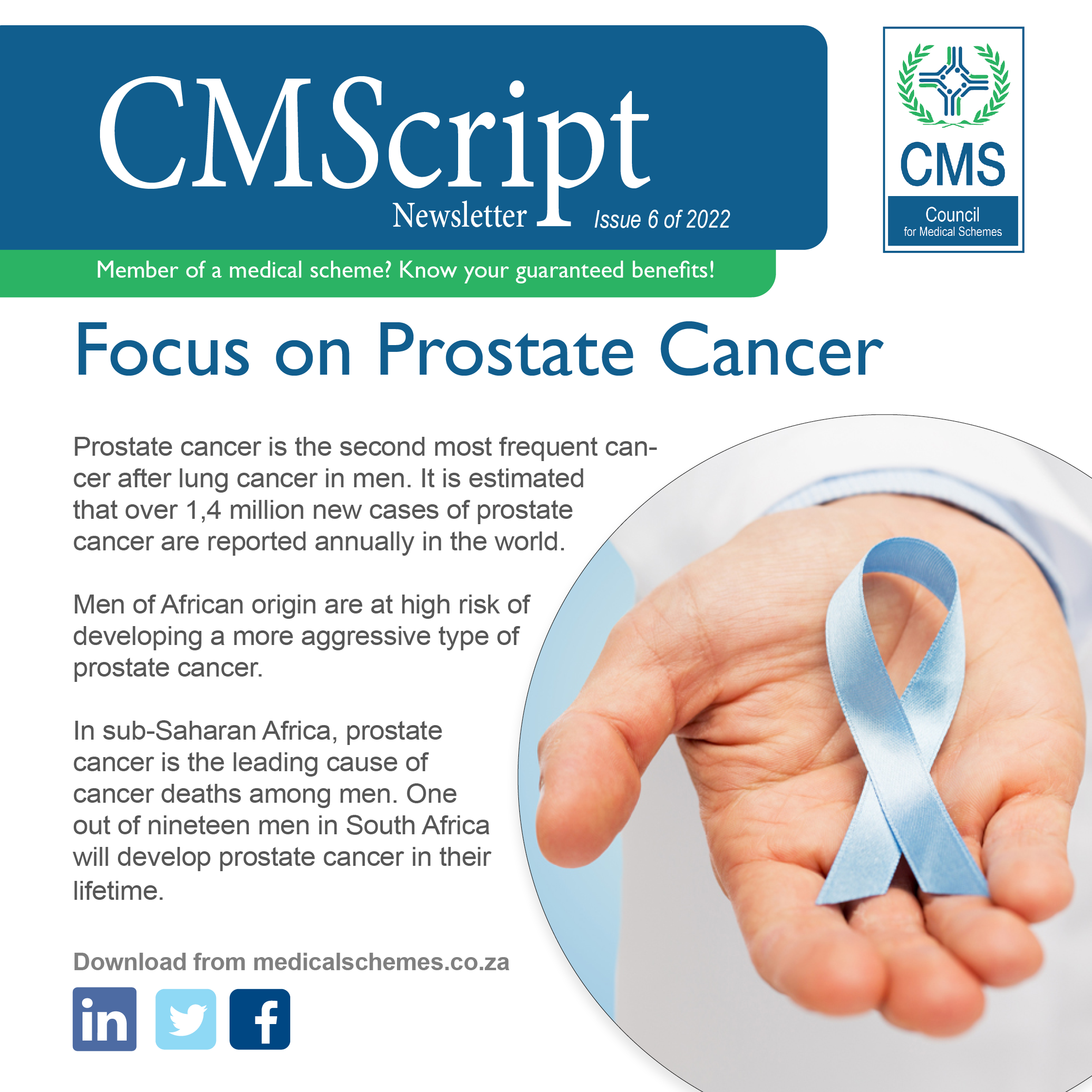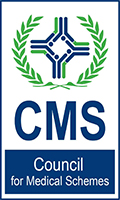
CMScript 6 of 2022: Focus on Prostate Cancer
Prostate cancer is the second most frequent cancer after lung cancer in men. It is estimated that over 1,4 million new cases of prostate cancer are reported annually in the world. Men of African origin are at high risk of developing a more aggressive type of prostate cancer. In sub-Saharan Africa, prostate cancer is the leading cause of cancer deaths among men. One out of nineteen men in South Africa will develop prostate cancer in their lifetime.
Download the CMScript here
- Risk factors
Men who are 40 years and older are at risk, and the risk increases rapidly after 50 years. Other risk factors are positive family history of prostate and/or breast cancer. Certain gene mutations (BRCA1 and BRCA2) increase the risk. BRCA1 has been associated with an increased risk of periodic incidences of prostate cancer, however, the risk increases 5-fold in males with BRCA2 mutations. Lifestyle and environmental factors such as smoking, alcohol intake, obesity, and poor diet (increased red meat and fatty food consumption) may increase the risk of developing prostate cancer.
- Signs and symptoms
Cancer in its early stages rarely produces symptoms. Symptoms of urinary obstruction usually occur in advanced stages of cancer. There may be blood in the urine or semen, painful ejaculation, urinary retention, difficulty and frequency of urination, and decreased size and force of the urinary stream. Cancer may sometimes spread to lymph nodes and bones. Symptoms of metastasis (spread) include backache, hip pain, perineal and rectal discomfort, anaemia, weight loss, weakness, decreased urine output and spontaneous pathological fractures.
- Screening
Screening is aimed at detecting cancer before the symptoms appear. This includes a Prostate Specific Antigen (PSA) blood test and a digital rectal exam (DRE).
- PSA – blood is tested for a protein produced by the prostate. High PSA high levels may indicate inflammation of the prostate or cancer.
- DRE – is the examination of the prostate through the rectum to check for any prostate abnormalities.
- Diagnostic tests
- PSA – men with a clinical suspicion of prostate cancer are offered a PSA.
- DRE – is recommended in all patients with elevated PSA levels.
- Prostate biopsy – men presenting with raised or rising PSA levels should be offered a biopsy as the abnormal PSA is non-specific in diagnosing cancer. Biopsy is the cornerstone of prostate cancer diagnosis. Perineal and/or trans-rectal ultrasound (sonar)-guided biopsy remains the standard of care for baseline biopsy.
- Lymph node biopsy – may be done if there is a suspicion that cancer has spread to the lymph nodes.
- Blood tests (Full Blood Count, Liver Function Tests, Urea and Electrolytes, Calcium, Haemoglobin) may also be performed.
Other tests which may be performed to determine the risk and staging of prostate cancer are:
- Computerised axial tomography (CAT scan) – makes a series of detailed pictures of areas inside the body, taken from different angles.
- Bone scan – detects whether there are rapidly dividing cells such as cancer cells in the bone.
- Magnetic resonance imaging (MRI) – uses a magnet, radio waves and a computer to make a series of detailed pictures of areas inside the body.
- Stages of cancer
Cancer staging describes how much and where the cancer is located.
- Stage I – the cancer is only found in the prostate.
- Stage II – is more advanced than stage I, but the cancer has not spread outside the prostate.
- Stage III – cancer has spread beyond the outer layer of the prostate and may have spread to the seminal vesicles.
- Stage IV – cancer may have spread to the seminal vesicles, rectum, bladder, pelvic wall, or to distant parts of the body which may include lymph nodes or bones.
- Management
There are several treatment options available.
6.1 Deferred treatment
Deferred treatment includes watchful waiting or active surveillance. Watchful waiting or active surveillance are treatment strategies which may be used for very low risk, low stage and low volume localised disease.
- Watchful waiting
Watchful waiting involves closely monitoring the patient’s condition without giving any treatment until signs or symptoms appear or change. The patient would then be treated according to the disease stage and presenting symptoms.
- Active surveillance
Active surveillance is closely following a patient’s condition without giving any treatment unless there are changes in test results. It is used to find early signs that the condition is getting worse. The aim is to avoid unnecessary treatment in men with localised prostate cancer who do not require immediate treatment, but at the same time achieve the correct treatment timing in those who may eventually need therapy.
6.2 Radical Prostatectomy
Radical prostatectomy is considered the standard first-line treatment for prostate cancer and is used in patients where the tumour is confined to the prostate. Care elements of radical prostatectomy include assessment for fitness of surgery and prostatectomy.
6.3 Radiation therapy
Radiation therapy is a cancer treatment that uses high-energy X-rays or other types of radiation to kill cancer cells or keep them from growing. There are two main ways of delivering the radiotherapy treatment, either directing the radiation from outside the body into the cancerous area (external beam radiotherapy) or by placing a small source of radiation inside the body close to or within the area where the tumour is located (brachytherapy)
6.4 Hormone therapy
Hormone therapy is a cancer treatment that removes hormones or blocks their action and stops cancer cells from growing. Hormones are substances made by glands in the body and circulated in the bloodstream.
6.5 Chemotherapy
Chemotherapy is a cancer treatment that uses drugs to stop the growth of cancer cells, either by killing the cells or by stopping them from dividing. When chemotherapy is taken by mouth or injected into a vein or muscle, the drugs enter the bloodstream and can reach cancer cells throughout the body.
- What is covered by the prescribed minimum benefits (PMBs)
Cancer of prostate gland – treatable is a PMB condition under Diagnosis and Treatment Pair (DTP) code 953L. Treatment component is specified as “Medical and surgical management, which includes chemotherapy and radiation therapy”.
In line with the National Department of Health’s (NDoH) policy document, medically informed patient-based screening is PMB level of care in males with a life expectancy of more than 10 years based on the following criteria:
- From the age of 40 in Black African patients and in those with a positive family history of prostate and/or breast cancer in a first-degree relative.
- From the age of 45 years in all other males.
- Patients with a history of lower urinary tract symptoms and/or clinical suspicion of prostate cancer regardless of age group.
Medical schemes are required by law to pay for the diagnosis, treatment and care costs of PMB conditions in full.
- Consultations, diagnostic and monitoring tests/investigations should be funded as PMB level of care.
- PMB level of care includes retropubic, trans perineal and transurethral prostatectomies (with or without lymph node dissection) and laparoscopic prostatectomy. Robotic assisted laparoscopic prostatectomy is not included as PMB level of care.
- Brachytherapy – permanent low dose radiation is PMB level of care. Temporary high-dose radiation is not PMB level of care.
- Radiotherapy – conventional radiotherapy, 3d conformal radiation therapy (3D-CRT) and intensity modulated radiotherapy are PMB level of care.
- Chemotherapy and hormone therapy – are considered PMB level of care for prostate cancer. Schemes may use formularies to determine the hormonal therapies that would be covered as PMB level of care.
More information on the tests/investigations and treatment that are considered PMB level of care are specified in the PMB Definition guideline for prostate cancer.
Download the CMScript here
References
- Council for Medical Schemes. 2014. CMScript: Prostate cancer. [online]. Available from: https://www.medicalschemes.co.za/publications/#2009-2137-wpfd-cmscript [Accessed 25 January 2025].
- Council for Medical Schemes. 2021. PMB benefit guideline: Prostate cancer 30 September 2021 v1. [online]. Available from: https://www.medicalschemes.co.za/publications/#2009-3566-wpfd-genitourinary [Accessed 25 January 2025].
- Castro, E. and Eeles, R. 2012. The role of BRCA1 and BRCA2 in prostate cancer. Asian Journal of Andrology, 14:409-414.
- Department of Health South Africa. 2020. Sexual and reproductive health healthy lifestyle month: Message booklet 2020. [online]. https://www.health.gov.za/wp-content/uploads/2020/11/sexual-and-reproductive-health-healthy-lifestyle-month-message-booklet-2020.pdf [Accessed 31 January 2022].
- Mersch, J., Jackson, M., Park, M., Nebgen, D., Peterson, S.K., Singletary, C., Arun, B.K. & Litton, J.K. 2015. Cancers associated with BRCA1 and BRCA2 mutations other than breast and ovarian. Cancer, 121(2): 269-275.
- Rawla, P. 2019. Epidemiology of prostate cancer. World Journal of Oncology, 10(2):63-89.
- Sung, H., Ferlay, J., Siegel, R.L., Laversanne, M., Soerjomataram, I., Jemal, A. & Bray, F. 2021. Global Cancer Statistics 2020: GLOBOCAN estimates of incidence and mortality worldwide for 36 cancers in 185 countries. Cancer Journal for Clinicians, 71:209-249


